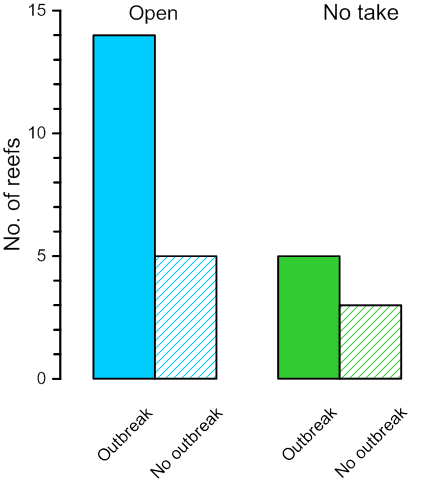Effects of marine park zoning on the incidence of crown-of-thorns outbreaks
The crown-of-thorns seastar, Acanthaster planci, is a predator of corals and along with cyclones is the major cause of coral mortality on the Great Barrier Reef (GBR) 1 . The GBR is currently experiencing the fourth wave of crown-of-thorns infestations since the 1960’s.
A comparison of the frequency of outbreaks on reefs open and closed to fishing (1994-2004) published in 2008, found the relative frequency of outbreaks on reefs that were open to fishing was 3.75 times higher than that on no-take reefs in the mid-shelf region of the GBR, where most of the outbreaks occur 2.
Rezoning of the GBRMP in 2004 increased the area of Marine National Park Green Zones from less than five per cent to 33 per cent of the Marine Park. The recent outbreaks on reefs north on Cairns provide a chance to test the findings published in 2008 with the new zoning plan that has been in place for 10 years.
Using the same criteria as in the 2008 study, reefs were considered to be “at risk” in any one year if they were 25 km north or south of a reef known to have outbreak densities of starfish. Twenty-seven reefs that were “at risk” were surveyed between 2012 and 2014.

The comparison of fished and no-take reefs surveyed in 2012 and 2014 found there was no conclusive evidence that zoning affects the incidence of outbreaks.
While a greater proportion of the reefs that were open to fishing had outbreaks than was the case for no-take reefs (Fig. 1), a majority of the no-take reefs did have outbreaks and the observed distribution could easily occur by chance (probability of this distribution or a more unequal one occurring by chance = 0.29, Fisher’s exact test).
1. De'ath G, Fabricius KE, Sweatman H. The 27–year decline of coral cover on the Great Barrier Reef and its causes. 2012; https://www.pnas.org/content/109/44/17995.short.
2. Sweatman H. No-take reserves protect coral reefs from predatory starfish. Current Biology Elsevier, 2008;18:R598–R599.





